Trade mark law in India PDF
VerifiedAdded on 2022/01/20
|14
|7202
|21
AI Summary
Contribute Materials
Your contribution can guide someone’s learning journey. Share your
documents today.
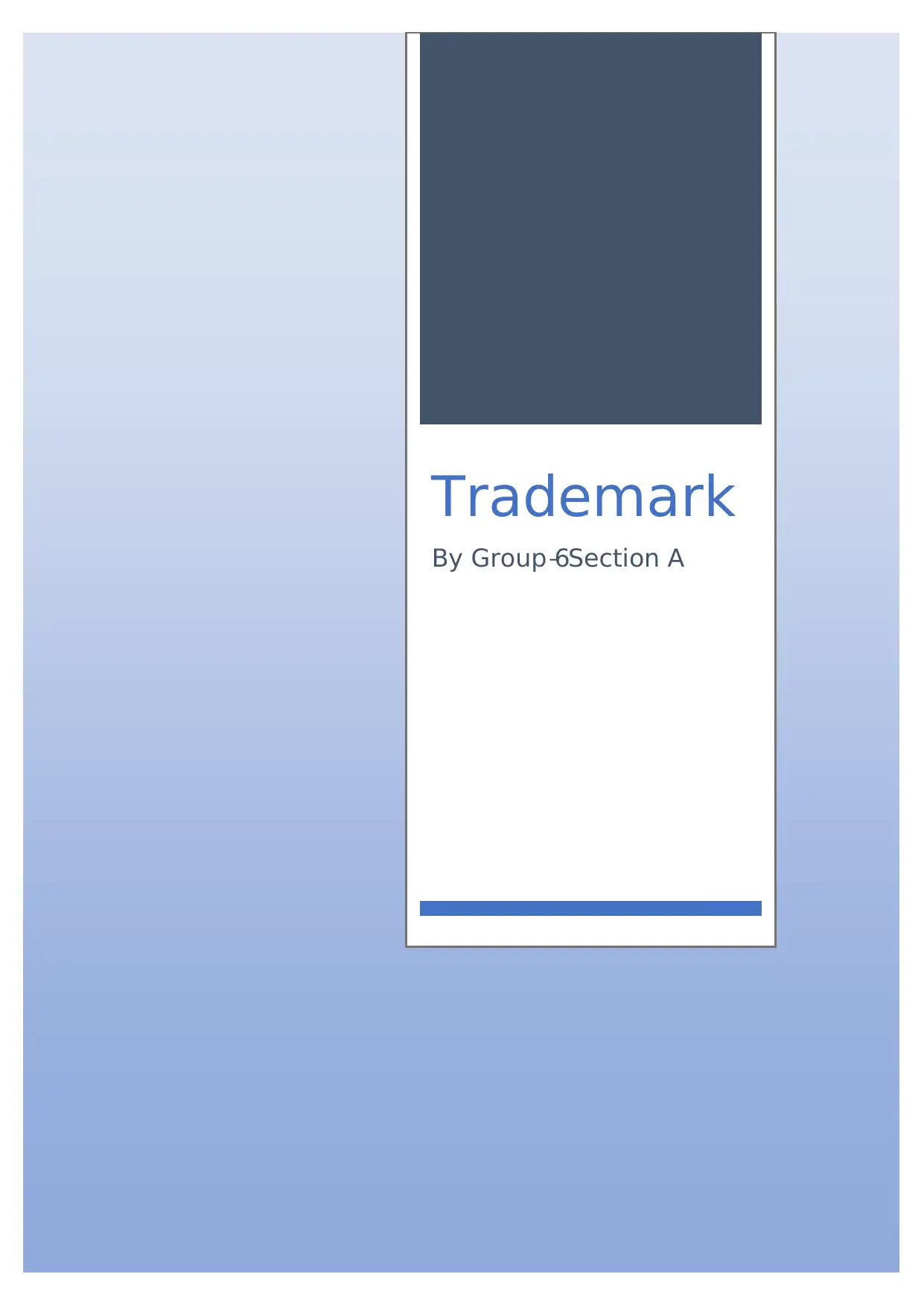
Trademark
By Group 6– Section A
By Group 6– Section A
Secure Best Marks with AI Grader
Need help grading? Try our AI Grader for instant feedback on your assignments.
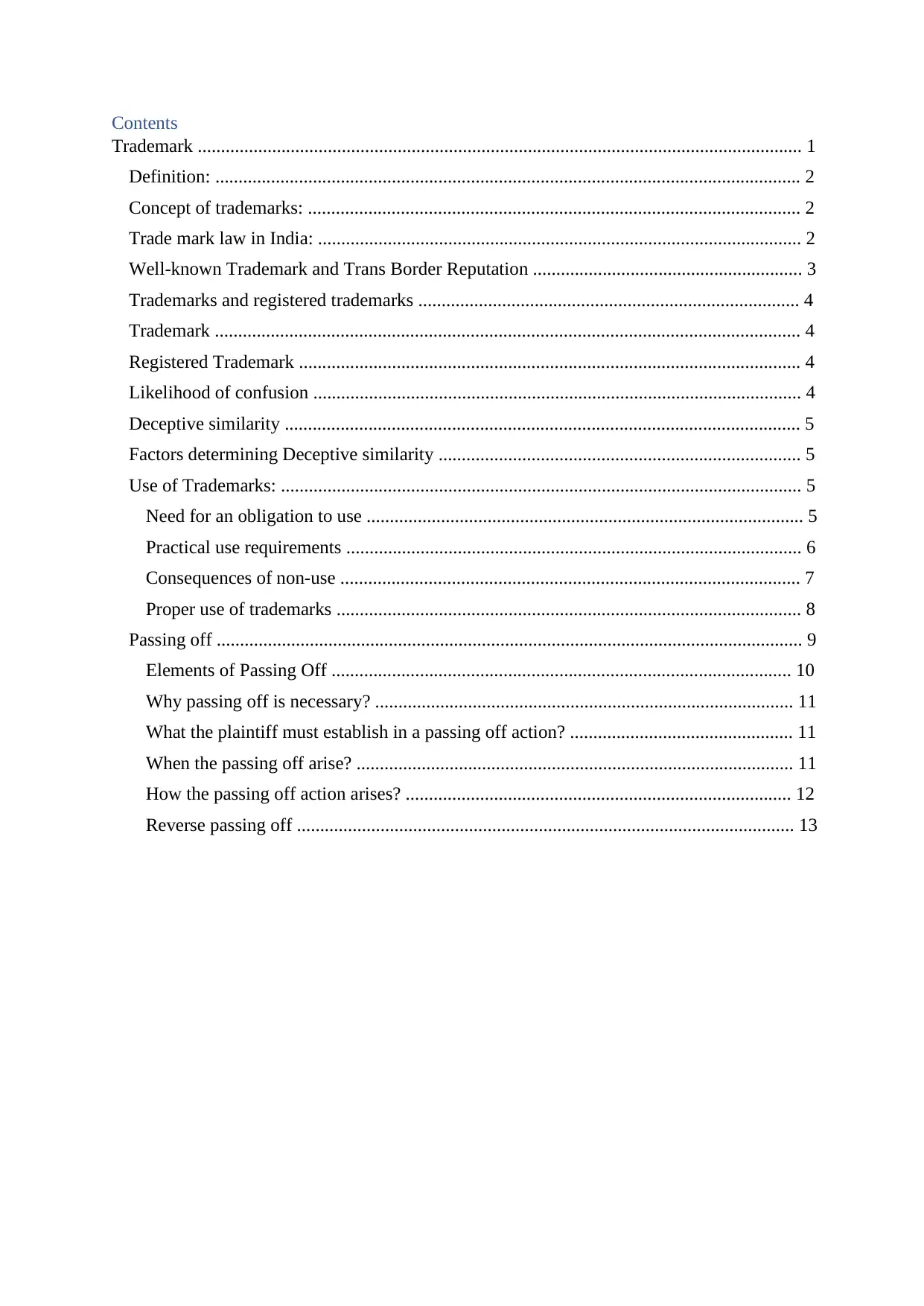
Contents
Trademark .................................................................................................................................. 1
Definition: .............................................................................................................................. 2
Concept of trademarks: .......................................................................................................... 2
Trade mark law in India: ........................................................................................................ 2
Well-known Trademark and Trans Border Reputation .......................................................... 3
Trademarks and registered trademarks .................................................................................. 4
Trademark .............................................................................................................................. 4
Registered Trademark ............................................................................................................ 4
Likelihood of confusion ......................................................................................................... 4
Deceptive similarity ............................................................................................................... 5
Factors determining Deceptive similarity .............................................................................. 5
Use of Trademarks: ................................................................................................................ 5
Need for an obligation to use .............................................................................................. 5
Practical use requirements .................................................................................................. 6
Consequences of non-use ................................................................................................... 7
Proper use of trademarks .................................................................................................... 8
Passing off .............................................................................................................................. 9
Elements of Passing Off ................................................................................................... 10
Why passing off is necessary? .......................................................................................... 11
What the plaintiff must establish in a passing off action? ................................................ 11
When the passing off arise? .............................................................................................. 11
How the passing off action arises? ................................................................................... 12
Reverse passing off ........................................................................................................... 13
Trademark .................................................................................................................................. 1
Definition: .............................................................................................................................. 2
Concept of trademarks: .......................................................................................................... 2
Trade mark law in India: ........................................................................................................ 2
Well-known Trademark and Trans Border Reputation .......................................................... 3
Trademarks and registered trademarks .................................................................................. 4
Trademark .............................................................................................................................. 4
Registered Trademark ............................................................................................................ 4
Likelihood of confusion ......................................................................................................... 4
Deceptive similarity ............................................................................................................... 5
Factors determining Deceptive similarity .............................................................................. 5
Use of Trademarks: ................................................................................................................ 5
Need for an obligation to use .............................................................................................. 5
Practical use requirements .................................................................................................. 6
Consequences of non-use ................................................................................................... 7
Proper use of trademarks .................................................................................................... 8
Passing off .............................................................................................................................. 9
Elements of Passing Off ................................................................................................... 10
Why passing off is necessary? .......................................................................................... 11
What the plaintiff must establish in a passing off action? ................................................ 11
When the passing off arise? .............................................................................................. 11
How the passing off action arises? ................................................................................... 12
Reverse passing off ........................................................................................................... 13
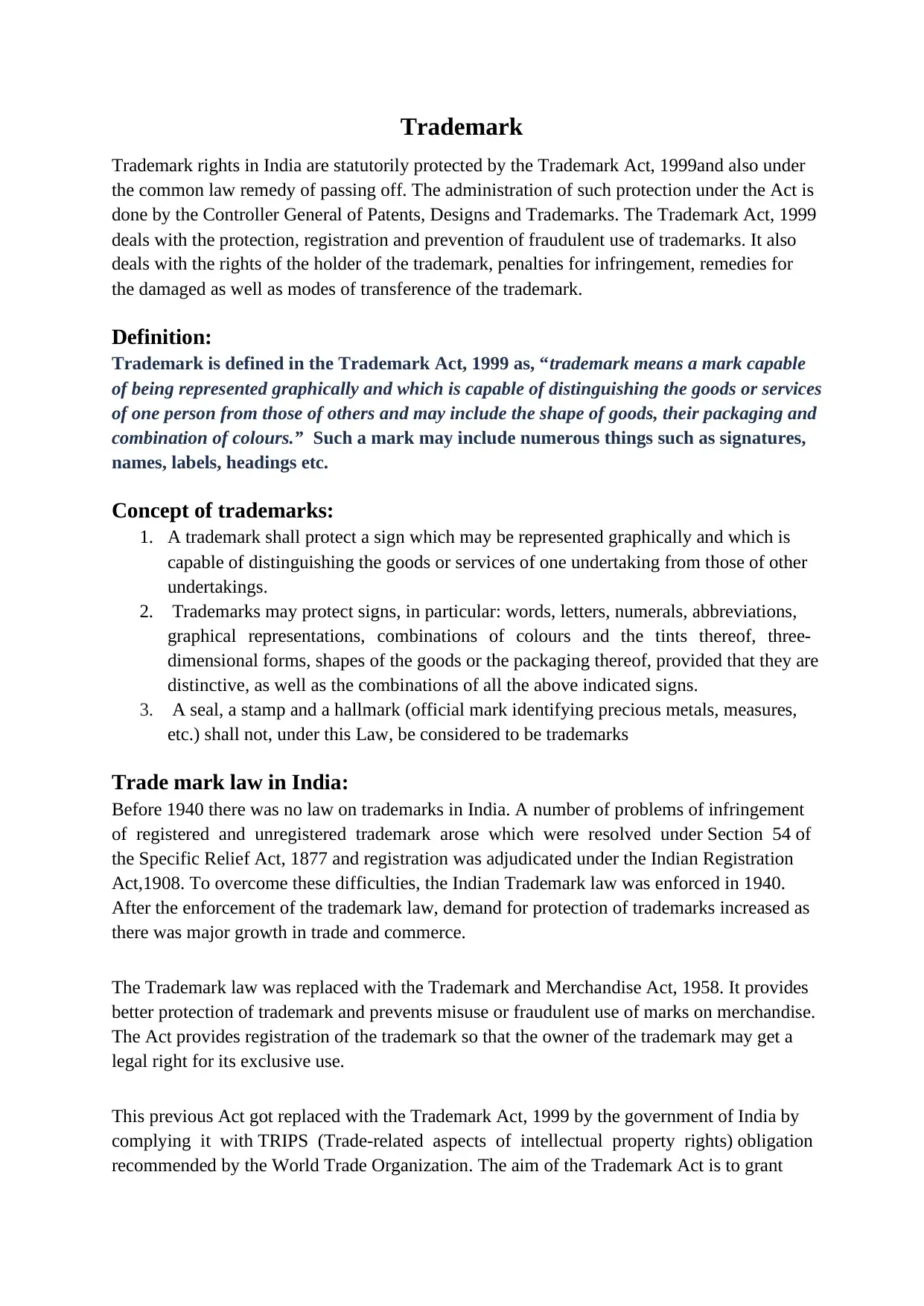
Trademark
Trademark rights in India are statutorily protected by the Trademark Act, 1999and also under
the common law remedy of passing off. The administration of such protection under the Act is
done by the Controller General of Patents, Designs and Trademarks. The Trademark Act, 1999
deals with the protection, registration and prevention of fraudulent use of trademarks. It also
deals with the rights of the holder of the trademark, penalties for infringement, remedies for
the damaged as well as modes of transference of the trademark.
Definition:
Trademark is defined in the Trademark Act, 1999 as, “trademark means a mark capable
of being represented graphically and which is capable of distinguishing the goods or services
of one person from those of others and may include the shape of goods, their packaging and
combination of colours.” Such a mark may include numerous things such as signatures,
names, labels, headings etc.
Concept of trademarks:
1. A trademark shall protect a sign which may be represented graphically and which is
capable of distinguishing the goods or services of one undertaking from those of other
undertakings.
2. Trademarks may protect signs, in particular: words, letters, numerals, abbreviations,
graphical representations, combinations of colours and the tints thereof, three-
dimensional forms, shapes of the goods or the packaging thereof, provided that they are
distinctive, as well as the combinations of all the above indicated signs.
3. A seal, a stamp and a hallmark (official mark identifying precious metals, measures,
etc.) shall not, under this Law, be considered to be trademarks
Trade mark law in India:
Before 1940 there was no law on trademarks in India. A number of problems of infringement
of registered and unregistered trademark arose which were resolved under Section 54 of
the Specific Relief Act, 1877 and registration was adjudicated under the Indian Registration
Act,1908. To overcome these difficulties, the Indian Trademark law was enforced in 1940.
After the enforcement of the trademark law, demand for protection of trademarks increased as
there was major growth in trade and commerce.
The Trademark law was replaced with the Trademark and Merchandise Act, 1958. It provides
better protection of trademark and prevents misuse or fraudulent use of marks on merchandise.
The Act provides registration of the trademark so that the owner of the trademark may get a
legal right for its exclusive use.
This previous Act got replaced with the Trademark Act, 1999 by the government of India by
complying it with TRIPS (Trade-related aspects of intellectual property rights) obligation
recommended by the World Trade Organization. The aim of the Trademark Act is to grant
Trademark rights in India are statutorily protected by the Trademark Act, 1999and also under
the common law remedy of passing off. The administration of such protection under the Act is
done by the Controller General of Patents, Designs and Trademarks. The Trademark Act, 1999
deals with the protection, registration and prevention of fraudulent use of trademarks. It also
deals with the rights of the holder of the trademark, penalties for infringement, remedies for
the damaged as well as modes of transference of the trademark.
Definition:
Trademark is defined in the Trademark Act, 1999 as, “trademark means a mark capable
of being represented graphically and which is capable of distinguishing the goods or services
of one person from those of others and may include the shape of goods, their packaging and
combination of colours.” Such a mark may include numerous things such as signatures,
names, labels, headings etc.
Concept of trademarks:
1. A trademark shall protect a sign which may be represented graphically and which is
capable of distinguishing the goods or services of one undertaking from those of other
undertakings.
2. Trademarks may protect signs, in particular: words, letters, numerals, abbreviations,
graphical representations, combinations of colours and the tints thereof, three-
dimensional forms, shapes of the goods or the packaging thereof, provided that they are
distinctive, as well as the combinations of all the above indicated signs.
3. A seal, a stamp and a hallmark (official mark identifying precious metals, measures,
etc.) shall not, under this Law, be considered to be trademarks
Trade mark law in India:
Before 1940 there was no law on trademarks in India. A number of problems of infringement
of registered and unregistered trademark arose which were resolved under Section 54 of
the Specific Relief Act, 1877 and registration was adjudicated under the Indian Registration
Act,1908. To overcome these difficulties, the Indian Trademark law was enforced in 1940.
After the enforcement of the trademark law, demand for protection of trademarks increased as
there was major growth in trade and commerce.
The Trademark law was replaced with the Trademark and Merchandise Act, 1958. It provides
better protection of trademark and prevents misuse or fraudulent use of marks on merchandise.
The Act provides registration of the trademark so that the owner of the trademark may get a
legal right for its exclusive use.
This previous Act got replaced with the Trademark Act, 1999 by the government of India by
complying it with TRIPS (Trade-related aspects of intellectual property rights) obligation
recommended by the World Trade Organization. The aim of the Trademark Act is to grant
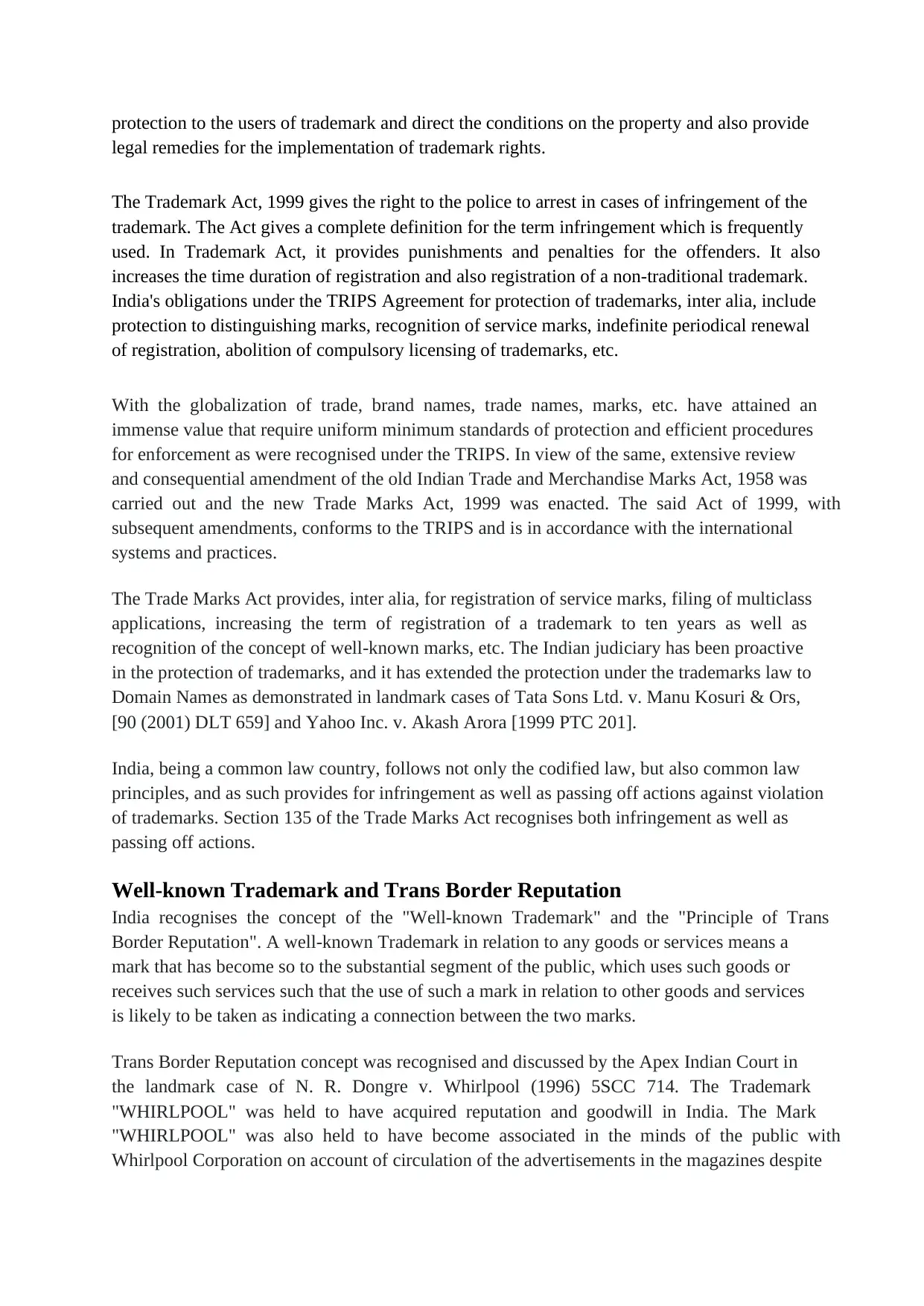
protection to the users of trademark and direct the conditions on the property and also provide
legal remedies for the implementation of trademark rights.
The Trademark Act, 1999 gives the right to the police to arrest in cases of infringement of the
trademark. The Act gives a complete definition for the term infringement which is frequently
used. In Trademark Act, it provides punishments and penalties for the offenders. It also
increases the time duration of registration and also registration of a non-traditional trademark.
India's obligations under the TRIPS Agreement for protection of trademarks, inter alia, include
protection to distinguishing marks, recognition of service marks, indefinite periodical renewal
of registration, abolition of compulsory licensing of trademarks, etc.
With the globalization of trade, brand names, trade names, marks, etc. have attained an
immense value that require uniform minimum standards of protection and efficient procedures
for enforcement as were recognised under the TRIPS. In view of the same, extensive review
and consequential amendment of the old Indian Trade and Merchandise Marks Act, 1958 was
carried out and the new Trade Marks Act, 1999 was enacted. The said Act of 1999, with
subsequent amendments, conforms to the TRIPS and is in accordance with the international
systems and practices.
The Trade Marks Act provides, inter alia, for registration of service marks, filing of multiclass
applications, increasing the term of registration of a trademark to ten years as well as
recognition of the concept of well-known marks, etc. The Indian judiciary has been proactive
in the protection of trademarks, and it has extended the protection under the trademarks law to
Domain Names as demonstrated in landmark cases of Tata Sons Ltd. v. Manu Kosuri & Ors,
[90 (2001) DLT 659] and Yahoo Inc. v. Akash Arora [1999 PTC 201].
India, being a common law country, follows not only the codified law, but also common law
principles, and as such provides for infringement as well as passing off actions against violation
of trademarks. Section 135 of the Trade Marks Act recognises both infringement as well as
passing off actions.
Well-known Trademark and Trans Border Reputation
India recognises the concept of the "Well-known Trademark" and the "Principle of Trans
Border Reputation". A well-known Trademark in relation to any goods or services means a
mark that has become so to the substantial segment of the public, which uses such goods or
receives such services such that the use of such a mark in relation to other goods and services
is likely to be taken as indicating a connection between the two marks.
Trans Border Reputation concept was recognised and discussed by the Apex Indian Court in
the landmark case of N. R. Dongre v. Whirlpool (1996) 5SCC 714. The Trademark
"WHIRLPOOL" was held to have acquired reputation and goodwill in India. The Mark
"WHIRLPOOL" was also held to have become associated in the minds of the public with
Whirlpool Corporation on account of circulation of the advertisements in the magazines despite
legal remedies for the implementation of trademark rights.
The Trademark Act, 1999 gives the right to the police to arrest in cases of infringement of the
trademark. The Act gives a complete definition for the term infringement which is frequently
used. In Trademark Act, it provides punishments and penalties for the offenders. It also
increases the time duration of registration and also registration of a non-traditional trademark.
India's obligations under the TRIPS Agreement for protection of trademarks, inter alia, include
protection to distinguishing marks, recognition of service marks, indefinite periodical renewal
of registration, abolition of compulsory licensing of trademarks, etc.
With the globalization of trade, brand names, trade names, marks, etc. have attained an
immense value that require uniform minimum standards of protection and efficient procedures
for enforcement as were recognised under the TRIPS. In view of the same, extensive review
and consequential amendment of the old Indian Trade and Merchandise Marks Act, 1958 was
carried out and the new Trade Marks Act, 1999 was enacted. The said Act of 1999, with
subsequent amendments, conforms to the TRIPS and is in accordance with the international
systems and practices.
The Trade Marks Act provides, inter alia, for registration of service marks, filing of multiclass
applications, increasing the term of registration of a trademark to ten years as well as
recognition of the concept of well-known marks, etc. The Indian judiciary has been proactive
in the protection of trademarks, and it has extended the protection under the trademarks law to
Domain Names as demonstrated in landmark cases of Tata Sons Ltd. v. Manu Kosuri & Ors,
[90 (2001) DLT 659] and Yahoo Inc. v. Akash Arora [1999 PTC 201].
India, being a common law country, follows not only the codified law, but also common law
principles, and as such provides for infringement as well as passing off actions against violation
of trademarks. Section 135 of the Trade Marks Act recognises both infringement as well as
passing off actions.
Well-known Trademark and Trans Border Reputation
India recognises the concept of the "Well-known Trademark" and the "Principle of Trans
Border Reputation". A well-known Trademark in relation to any goods or services means a
mark that has become so to the substantial segment of the public, which uses such goods or
receives such services such that the use of such a mark in relation to other goods and services
is likely to be taken as indicating a connection between the two marks.
Trans Border Reputation concept was recognised and discussed by the Apex Indian Court in
the landmark case of N. R. Dongre v. Whirlpool (1996) 5SCC 714. The Trademark
"WHIRLPOOL" was held to have acquired reputation and goodwill in India. The Mark
"WHIRLPOOL" was also held to have become associated in the minds of the public with
Whirlpool Corporation on account of circulation of the advertisements in the magazines despite
Secure Best Marks with AI Grader
Need help grading? Try our AI Grader for instant feedback on your assignments.
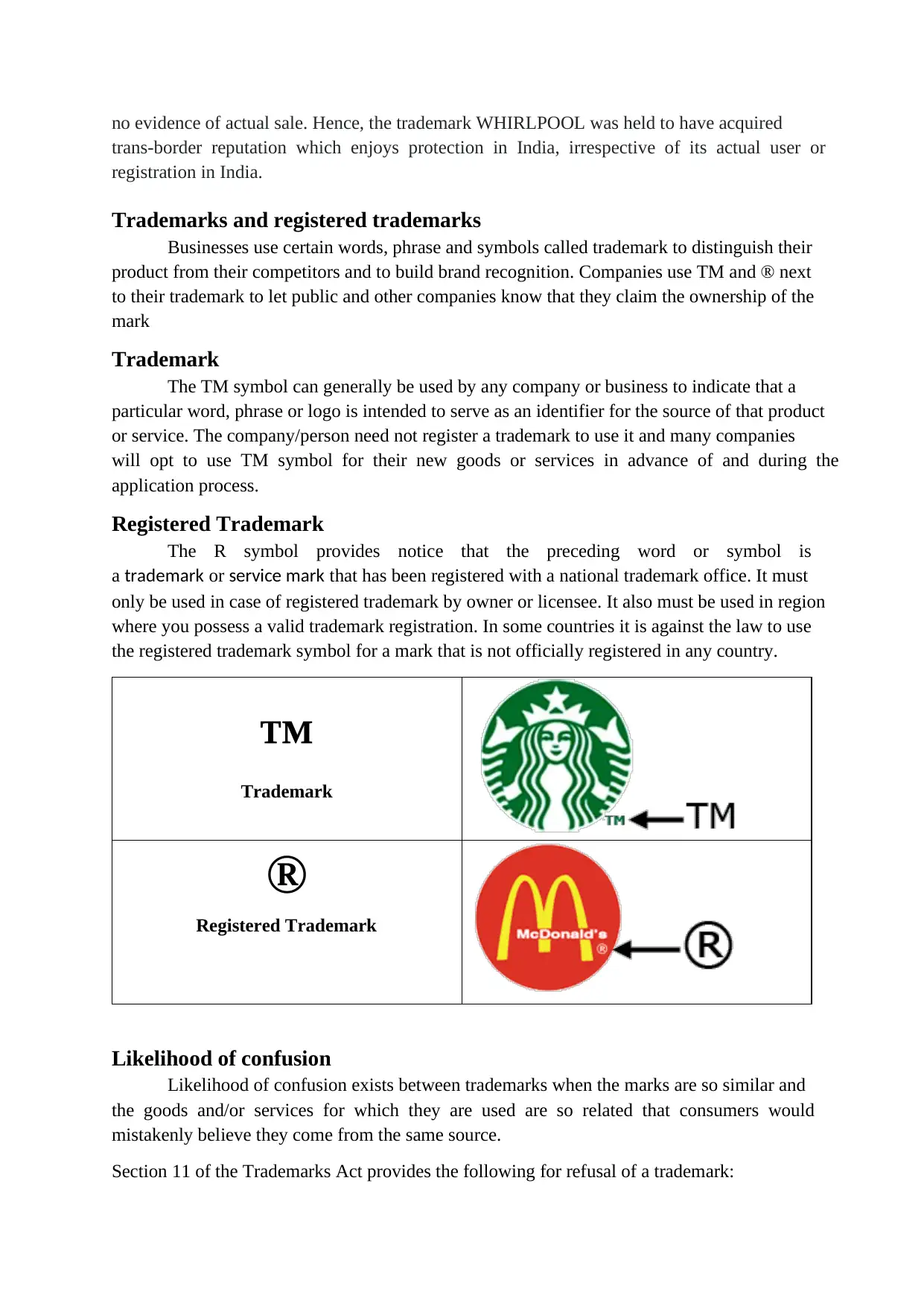
no evidence of actual sale. Hence, the trademark WHIRLPOOL was held to have acquired
trans-border reputation which enjoys protection in India, irrespective of its actual user or
registration in India.
Trademarks and registered trademarks
Businesses use certain words, phrase and symbols called trademark to distinguish their
product from their competitors and to build brand recognition. Companies use TM and ® next
to their trademark to let public and other companies know that they claim the ownership of the
mark
Trademark
The TM symbol can generally be used by any company or business to indicate that a
particular word, phrase or logo is intended to serve as an identifier for the source of that product
or service. The company/person need not register a trademark to use it and many companies
will opt to use TM symbol for their new goods or services in advance of and during the
application process.
Registered Trademark
The R symbol provides notice that the preceding word or symbol is
a trademark or service mark that has been registered with a national trademark office. It must
only be used in case of registered trademark by owner or licensee. It also must be used in region
where you possess a valid trademark registration. In some countries it is against the law to use
the registered trademark symbol for a mark that is not officially registered in any country.
™
Trademark
®
Registered Trademark
Likelihood of confusion
Likelihood of confusion exists between trademarks when the marks are so similar and
the goods and/or services for which they are used are so related that consumers would
mistakenly believe they come from the same source.
Section 11 of the Trademarks Act provides the following for refusal of a trademark:
trans-border reputation which enjoys protection in India, irrespective of its actual user or
registration in India.
Trademarks and registered trademarks
Businesses use certain words, phrase and symbols called trademark to distinguish their
product from their competitors and to build brand recognition. Companies use TM and ® next
to their trademark to let public and other companies know that they claim the ownership of the
mark
Trademark
The TM symbol can generally be used by any company or business to indicate that a
particular word, phrase or logo is intended to serve as an identifier for the source of that product
or service. The company/person need not register a trademark to use it and many companies
will opt to use TM symbol for their new goods or services in advance of and during the
application process.
Registered Trademark
The R symbol provides notice that the preceding word or symbol is
a trademark or service mark that has been registered with a national trademark office. It must
only be used in case of registered trademark by owner or licensee. It also must be used in region
where you possess a valid trademark registration. In some countries it is against the law to use
the registered trademark symbol for a mark that is not officially registered in any country.
™
Trademark
®
Registered Trademark
Likelihood of confusion
Likelihood of confusion exists between trademarks when the marks are so similar and
the goods and/or services for which they are used are so related that consumers would
mistakenly believe they come from the same source.
Section 11 of the Trademarks Act provides the following for refusal of a trademark:
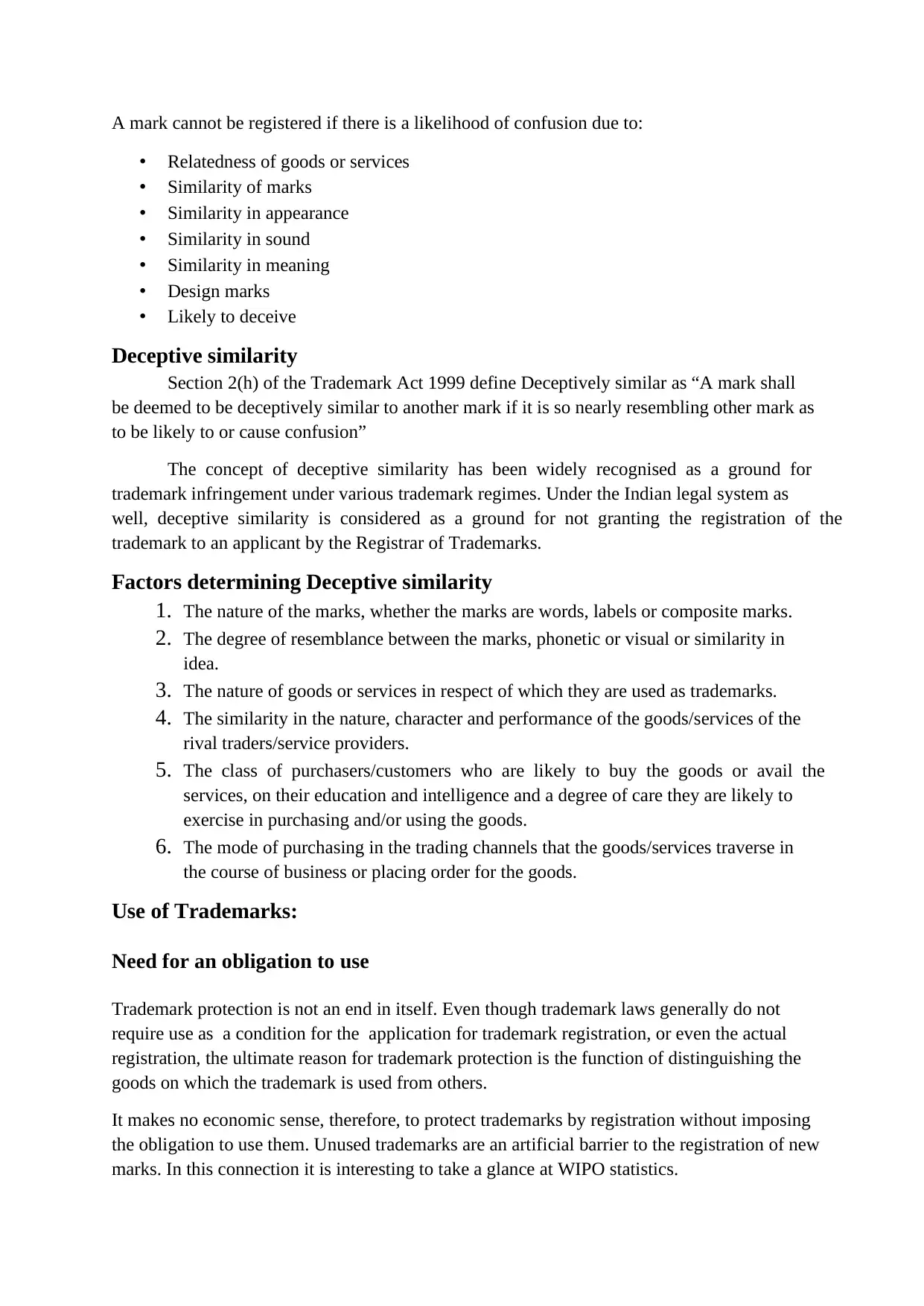
A mark cannot be registered if there is a likelihood of confusion due to:
• Relatedness of goods or services
• Similarity of marks
• Similarity in appearance
• Similarity in sound
• Similarity in meaning
• Design marks
• Likely to deceive
Deceptive similarity
Section 2(h) of the Trademark Act 1999 define Deceptively similar as “A mark shall
be deemed to be deceptively similar to another mark if it is so nearly resembling other mark as
to be likely to or cause confusion”
The concept of deceptive similarity has been widely recognised as a ground for
trademark infringement under various trademark regimes. Under the Indian legal system as
well, deceptive similarity is considered as a ground for not granting the registration of the
trademark to an applicant by the Registrar of Trademarks.
Factors determining Deceptive similarity
1. The nature of the marks, whether the marks are words, labels or composite marks.
2. The degree of resemblance between the marks, phonetic or visual or similarity in
idea.
3. The nature of goods or services in respect of which they are used as trademarks.
4. The similarity in the nature, character and performance of the goods/services of the
rival traders/service providers.
5. The class of purchasers/customers who are likely to buy the goods or avail the
services, on their education and intelligence and a degree of care they are likely to
exercise in purchasing and/or using the goods.
6. The mode of purchasing in the trading channels that the goods/services traverse in
the course of business or placing order for the goods.
Use of Trademarks:
Need for an obligation to use
Trademark protection is not an end in itself. Even though trademark laws generally do not
require use as a condition for the application for trademark registration, or even the actual
registration, the ultimate reason for trademark protection is the function of distinguishing the
goods on which the trademark is used from others.
It makes no economic sense, therefore, to protect trademarks by registration without imposing
the obligation to use them. Unused trademarks are an artificial barrier to the registration of new
marks. In this connection it is interesting to take a glance at WIPO statistics.
• Relatedness of goods or services
• Similarity of marks
• Similarity in appearance
• Similarity in sound
• Similarity in meaning
• Design marks
• Likely to deceive
Deceptive similarity
Section 2(h) of the Trademark Act 1999 define Deceptively similar as “A mark shall
be deemed to be deceptively similar to another mark if it is so nearly resembling other mark as
to be likely to or cause confusion”
The concept of deceptive similarity has been widely recognised as a ground for
trademark infringement under various trademark regimes. Under the Indian legal system as
well, deceptive similarity is considered as a ground for not granting the registration of the
trademark to an applicant by the Registrar of Trademarks.
Factors determining Deceptive similarity
1. The nature of the marks, whether the marks are words, labels or composite marks.
2. The degree of resemblance between the marks, phonetic or visual or similarity in
idea.
3. The nature of goods or services in respect of which they are used as trademarks.
4. The similarity in the nature, character and performance of the goods/services of the
rival traders/service providers.
5. The class of purchasers/customers who are likely to buy the goods or avail the
services, on their education and intelligence and a degree of care they are likely to
exercise in purchasing and/or using the goods.
6. The mode of purchasing in the trading channels that the goods/services traverse in
the course of business or placing order for the goods.
Use of Trademarks:
Need for an obligation to use
Trademark protection is not an end in itself. Even though trademark laws generally do not
require use as a condition for the application for trademark registration, or even the actual
registration, the ultimate reason for trademark protection is the function of distinguishing the
goods on which the trademark is used from others.
It makes no economic sense, therefore, to protect trademarks by registration without imposing
the obligation to use them. Unused trademarks are an artificial barrier to the registration of new
marks. In this connection it is interesting to take a glance at WIPO statistics.
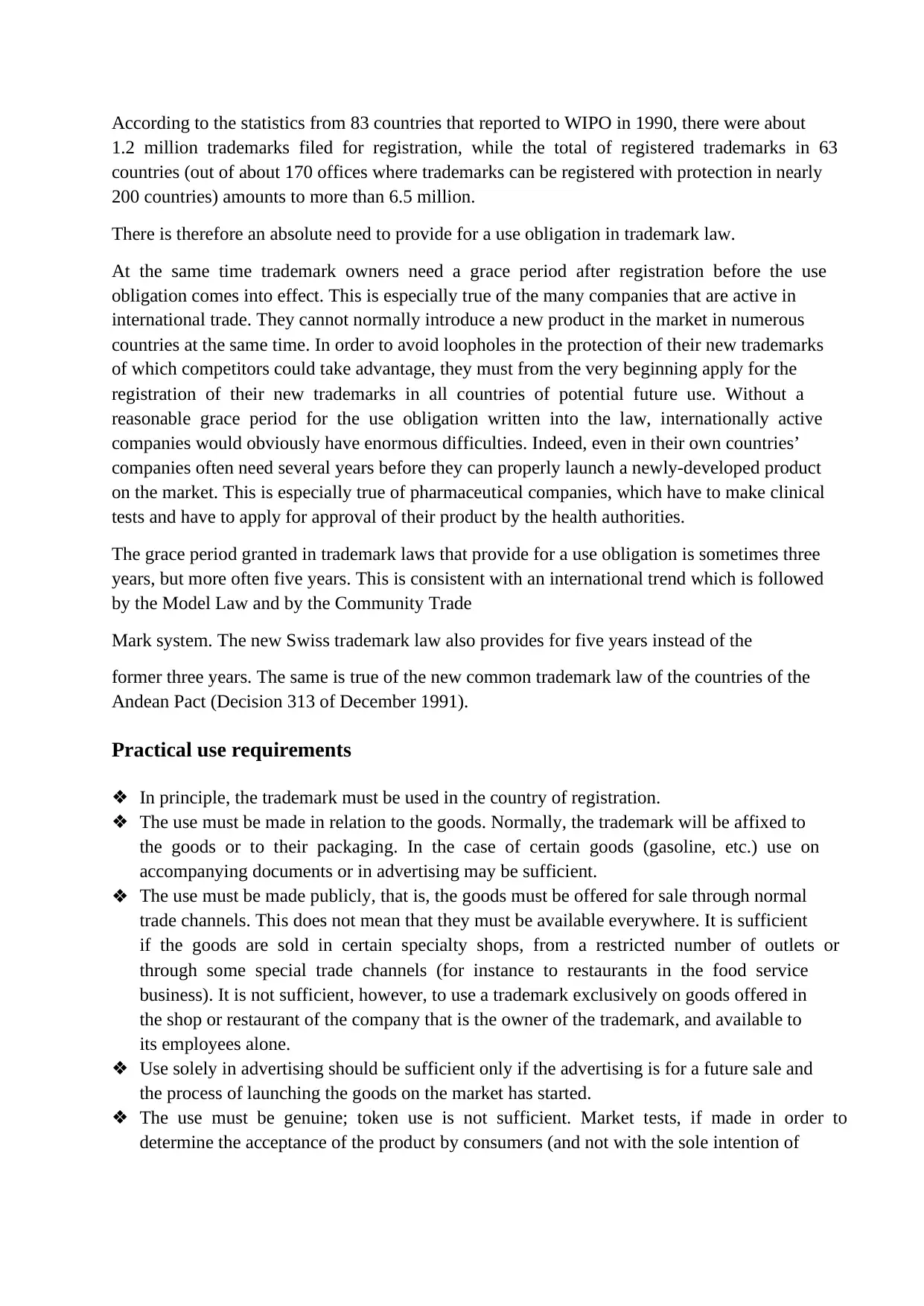
According to the statistics from 83 countries that reported to WIPO in 1990, there were about
1.2 million trademarks filed for registration, while the total of registered trademarks in 63
countries (out of about 170 offices where trademarks can be registered with protection in nearly
200 countries) amounts to more than 6.5 million.
There is therefore an absolute need to provide for a use obligation in trademark law.
At the same time trademark owners need a grace period after registration before the use
obligation comes into effect. This is especially true of the many companies that are active in
international trade. They cannot normally introduce a new product in the market in numerous
countries at the same time. In order to avoid loopholes in the protection of their new trademarks
of which competitors could take advantage, they must from the very beginning apply for the
registration of their new trademarks in all countries of potential future use. Without a
reasonable grace period for the use obligation written into the law, internationally active
companies would obviously have enormous difficulties. Indeed, even in their own countries’
companies often need several years before they can properly launch a newly-developed product
on the market. This is especially true of pharmaceutical companies, which have to make clinical
tests and have to apply for approval of their product by the health authorities.
The grace period granted in trademark laws that provide for a use obligation is sometimes three
years, but more often five years. This is consistent with an international trend which is followed
by the Model Law and by the Community Trade
Mark system. The new Swiss trademark law also provides for five years instead of the
former three years. The same is true of the new common trademark law of the countries of the
Andean Pact (Decision 313 of December 1991).
Practical use requirements
❖ In principle, the trademark must be used in the country of registration.
❖ The use must be made in relation to the goods. Normally, the trademark will be affixed to
the goods or to their packaging. In the case of certain goods (gasoline, etc.) use on
accompanying documents or in advertising may be sufficient.
❖ The use must be made publicly, that is, the goods must be offered for sale through normal
trade channels. This does not mean that they must be available everywhere. It is sufficient
if the goods are sold in certain specialty shops, from a restricted number of outlets or
through some special trade channels (for instance to restaurants in the food service
business). It is not sufficient, however, to use a trademark exclusively on goods offered in
the shop or restaurant of the company that is the owner of the trademark, and available to
its employees alone.
❖ Use solely in advertising should be sufficient only if the advertising is for a future sale and
the process of launching the goods on the market has started.
❖ The use must be genuine; token use is not sufficient. Market tests, if made in order to
determine the acceptance of the product by consumers (and not with the sole intention of
1.2 million trademarks filed for registration, while the total of registered trademarks in 63
countries (out of about 170 offices where trademarks can be registered with protection in nearly
200 countries) amounts to more than 6.5 million.
There is therefore an absolute need to provide for a use obligation in trademark law.
At the same time trademark owners need a grace period after registration before the use
obligation comes into effect. This is especially true of the many companies that are active in
international trade. They cannot normally introduce a new product in the market in numerous
countries at the same time. In order to avoid loopholes in the protection of their new trademarks
of which competitors could take advantage, they must from the very beginning apply for the
registration of their new trademarks in all countries of potential future use. Without a
reasonable grace period for the use obligation written into the law, internationally active
companies would obviously have enormous difficulties. Indeed, even in their own countries’
companies often need several years before they can properly launch a newly-developed product
on the market. This is especially true of pharmaceutical companies, which have to make clinical
tests and have to apply for approval of their product by the health authorities.
The grace period granted in trademark laws that provide for a use obligation is sometimes three
years, but more often five years. This is consistent with an international trend which is followed
by the Model Law and by the Community Trade
Mark system. The new Swiss trademark law also provides for five years instead of the
former three years. The same is true of the new common trademark law of the countries of the
Andean Pact (Decision 313 of December 1991).
Practical use requirements
❖ In principle, the trademark must be used in the country of registration.
❖ The use must be made in relation to the goods. Normally, the trademark will be affixed to
the goods or to their packaging. In the case of certain goods (gasoline, etc.) use on
accompanying documents or in advertising may be sufficient.
❖ The use must be made publicly, that is, the goods must be offered for sale through normal
trade channels. This does not mean that they must be available everywhere. It is sufficient
if the goods are sold in certain specialty shops, from a restricted number of outlets or
through some special trade channels (for instance to restaurants in the food service
business). It is not sufficient, however, to use a trademark exclusively on goods offered in
the shop or restaurant of the company that is the owner of the trademark, and available to
its employees alone.
❖ Use solely in advertising should be sufficient only if the advertising is for a future sale and
the process of launching the goods on the market has started.
❖ The use must be genuine; token use is not sufficient. Market tests, if made in order to
determine the acceptance of the product by consumers (and not with the sole intention of
Paraphrase This Document
Need a fresh take? Get an instant paraphrase of this document with our AI Paraphraser
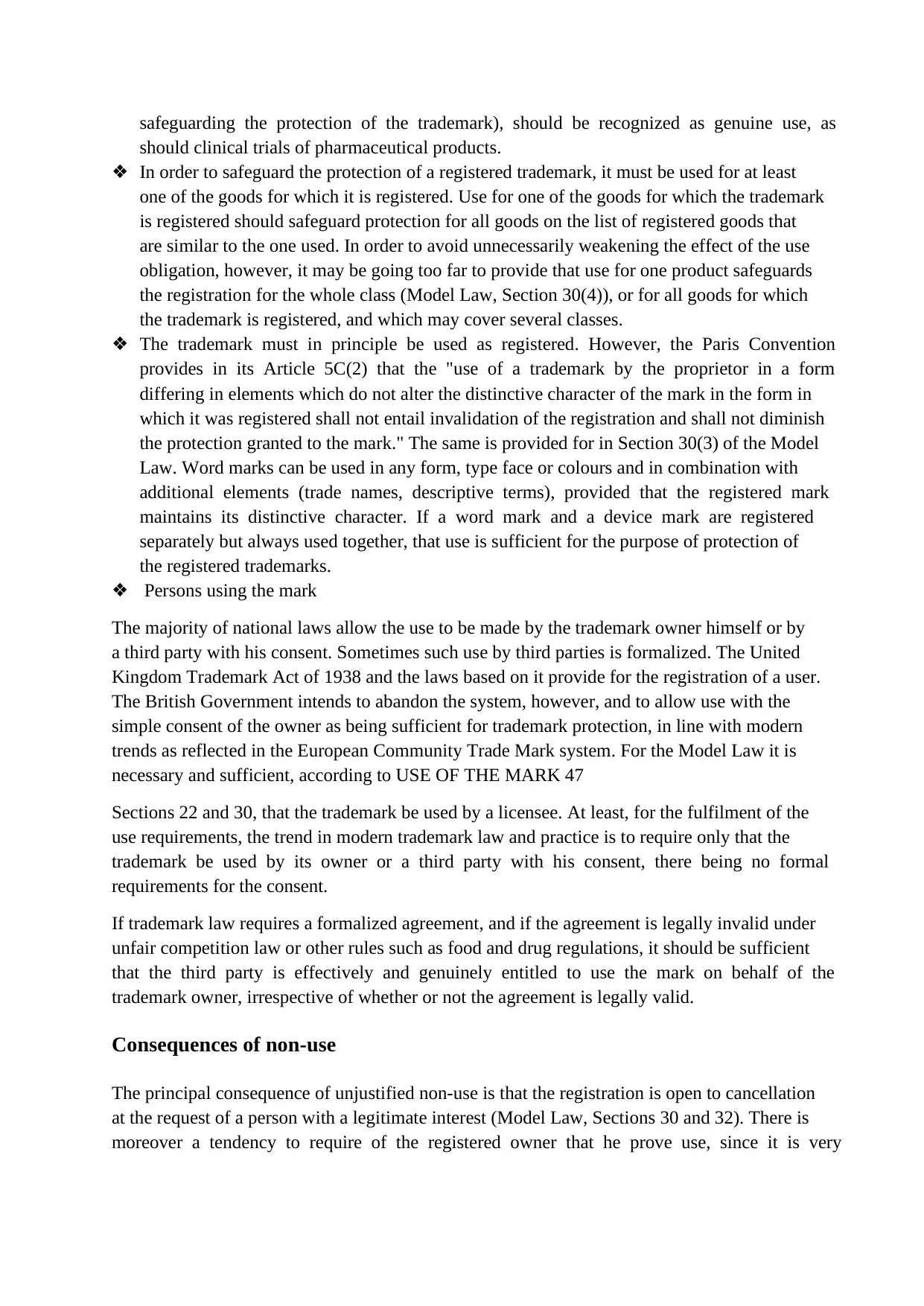
safeguarding the protection of the trademark), should be recognized as genuine use, as
should clinical trials of pharmaceutical products.
❖ In order to safeguard the protection of a registered trademark, it must be used for at least
one of the goods for which it is registered. Use for one of the goods for which the trademark
is registered should safeguard protection for all goods on the list of registered goods that
are similar to the one used. In order to avoid unnecessarily weakening the effect of the use
obligation, however, it may be going too far to provide that use for one product safeguards
the registration for the whole class (Model Law, Section 30(4)), or for all goods for which
the trademark is registered, and which may cover several classes.
❖ The trademark must in principle be used as registered. However, the Paris Convention
provides in its Article 5C(2) that the "use of a trademark by the proprietor in a form
differing in elements which do not alter the distinctive character of the mark in the form in
which it was registered shall not entail invalidation of the registration and shall not diminish
the protection granted to the mark." The same is provided for in Section 30(3) of the Model
Law. Word marks can be used in any form, type face or colours and in combination with
additional elements (trade names, descriptive terms), provided that the registered mark
maintains its distinctive character. If a word mark and a device mark are registered
separately but always used together, that use is sufficient for the purpose of protection of
the registered trademarks.
❖ Persons using the mark
The majority of national laws allow the use to be made by the trademark owner himself or by
a third party with his consent. Sometimes such use by third parties is formalized. The United
Kingdom Trademark Act of 1938 and the laws based on it provide for the registration of a user.
The British Government intends to abandon the system, however, and to allow use with the
simple consent of the owner as being sufficient for trademark protection, in line with modern
trends as reflected in the European Community Trade Mark system. For the Model Law it is
necessary and sufficient, according to USE OF THE MARK 47
Sections 22 and 30, that the trademark be used by a licensee. At least, for the fulfilment of the
use requirements, the trend in modern trademark law and practice is to require only that the
trademark be used by its owner or a third party with his consent, there being no formal
requirements for the consent.
If trademark law requires a formalized agreement, and if the agreement is legally invalid under
unfair competition law or other rules such as food and drug regulations, it should be sufficient
that the third party is effectively and genuinely entitled to use the mark on behalf of the
trademark owner, irrespective of whether or not the agreement is legally valid.
Consequences of non-use
The principal consequence of unjustified non-use is that the registration is open to cancellation
at the request of a person with a legitimate interest (Model Law, Sections 30 and 32). There is
moreover a tendency to require of the registered owner that he prove use, since it is very
should clinical trials of pharmaceutical products.
❖ In order to safeguard the protection of a registered trademark, it must be used for at least
one of the goods for which it is registered. Use for one of the goods for which the trademark
is registered should safeguard protection for all goods on the list of registered goods that
are similar to the one used. In order to avoid unnecessarily weakening the effect of the use
obligation, however, it may be going too far to provide that use for one product safeguards
the registration for the whole class (Model Law, Section 30(4)), or for all goods for which
the trademark is registered, and which may cover several classes.
❖ The trademark must in principle be used as registered. However, the Paris Convention
provides in its Article 5C(2) that the "use of a trademark by the proprietor in a form
differing in elements which do not alter the distinctive character of the mark in the form in
which it was registered shall not entail invalidation of the registration and shall not diminish
the protection granted to the mark." The same is provided for in Section 30(3) of the Model
Law. Word marks can be used in any form, type face or colours and in combination with
additional elements (trade names, descriptive terms), provided that the registered mark
maintains its distinctive character. If a word mark and a device mark are registered
separately but always used together, that use is sufficient for the purpose of protection of
the registered trademarks.
❖ Persons using the mark
The majority of national laws allow the use to be made by the trademark owner himself or by
a third party with his consent. Sometimes such use by third parties is formalized. The United
Kingdom Trademark Act of 1938 and the laws based on it provide for the registration of a user.
The British Government intends to abandon the system, however, and to allow use with the
simple consent of the owner as being sufficient for trademark protection, in line with modern
trends as reflected in the European Community Trade Mark system. For the Model Law it is
necessary and sufficient, according to USE OF THE MARK 47
Sections 22 and 30, that the trademark be used by a licensee. At least, for the fulfilment of the
use requirements, the trend in modern trademark law and practice is to require only that the
trademark be used by its owner or a third party with his consent, there being no formal
requirements for the consent.
If trademark law requires a formalized agreement, and if the agreement is legally invalid under
unfair competition law or other rules such as food and drug regulations, it should be sufficient
that the third party is effectively and genuinely entitled to use the mark on behalf of the
trademark owner, irrespective of whether or not the agreement is legally valid.
Consequences of non-use
The principal consequence of unjustified non-use is that the registration is open to cancellation
at the request of a person with a legitimate interest (Model Law, Sections 30 and 32). There is
moreover a tendency to require of the registered owner that he prove use, since it is very
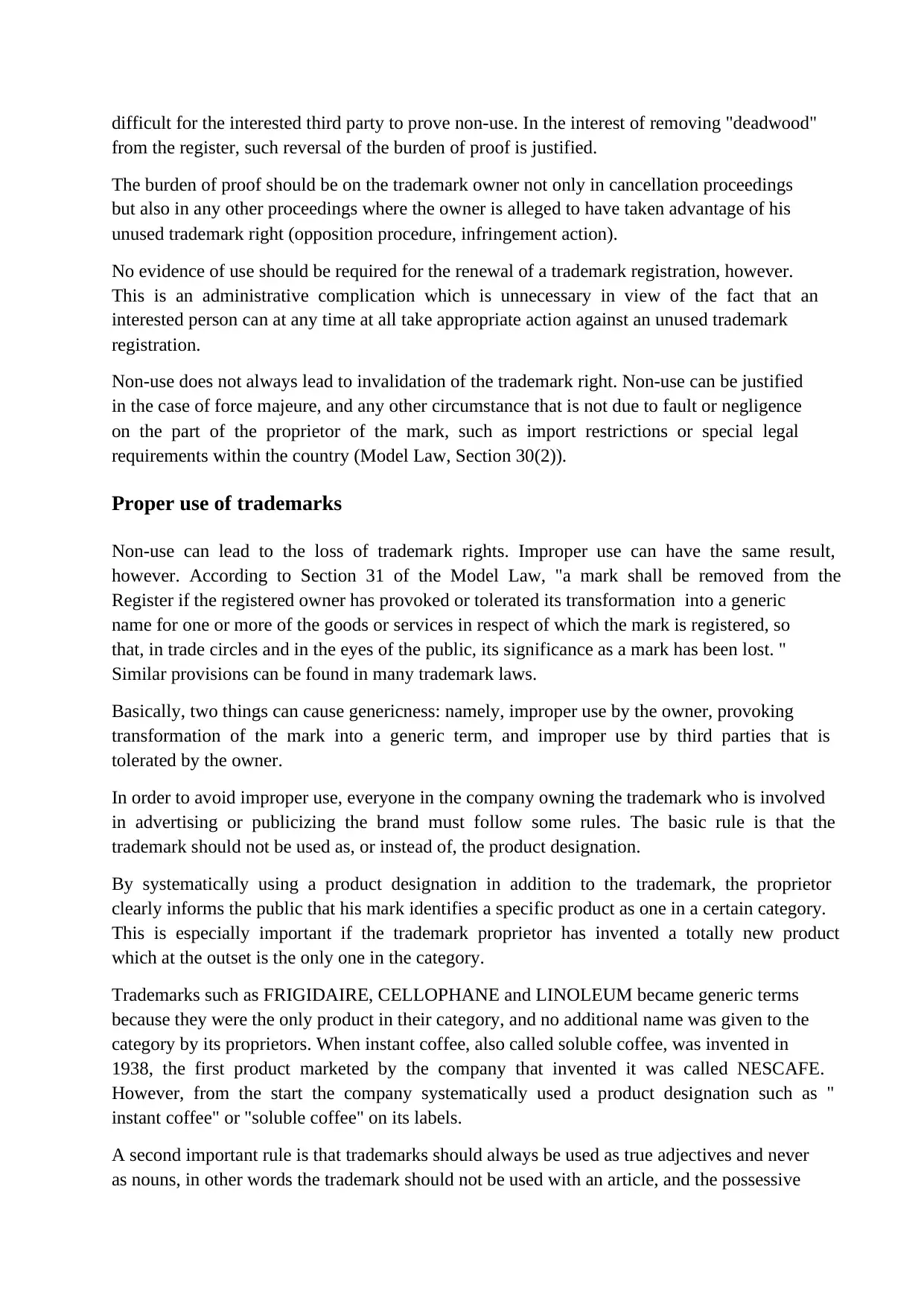
difficult for the interested third party to prove non-use. In the interest of removing "deadwood"
from the register, such reversal of the burden of proof is justified.
The burden of proof should be on the trademark owner not only in cancellation proceedings
but also in any other proceedings where the owner is alleged to have taken advantage of his
unused trademark right (opposition procedure, infringement action).
No evidence of use should be required for the renewal of a trademark registration, however.
This is an administrative complication which is unnecessary in view of the fact that an
interested person can at any time at all take appropriate action against an unused trademark
registration.
Non-use does not always lead to invalidation of the trademark right. Non-use can be justified
in the case of force majeure, and any other circumstance that is not due to fault or negligence
on the part of the proprietor of the mark, such as import restrictions or special legal
requirements within the country (Model Law, Section 30(2)).
Proper use of trademarks
Non-use can lead to the loss of trademark rights. Improper use can have the same result,
however. According to Section 31 of the Model Law, "a mark shall be removed from the
Register if the registered owner has provoked or tolerated its transformation into a generic
name for one or more of the goods or services in respect of which the mark is registered, so
that, in trade circles and in the eyes of the public, its significance as a mark has been lost. "
Similar provisions can be found in many trademark laws.
Basically, two things can cause genericness: namely, improper use by the owner, provoking
transformation of the mark into a generic term, and improper use by third parties that is
tolerated by the owner.
In order to avoid improper use, everyone in the company owning the trademark who is involved
in advertising or publicizing the brand must follow some rules. The basic rule is that the
trademark should not be used as, or instead of, the product designation.
By systematically using a product designation in addition to the trademark, the proprietor
clearly informs the public that his mark identifies a specific product as one in a certain category.
This is especially important if the trademark proprietor has invented a totally new product
which at the outset is the only one in the category.
Trademarks such as FRIGIDAIRE, CELLOPHANE and LINOLEUM became generic terms
because they were the only product in their category, and no additional name was given to the
category by its proprietors. When instant coffee, also called soluble coffee, was invented in
1938, the first product marketed by the company that invented it was called NESCAFE.
However, from the start the company systematically used a product designation such as "
instant coffee" or "soluble coffee" on its labels.
A second important rule is that trademarks should always be used as true adjectives and never
as nouns, in other words the trademark should not be used with an article, and the possessive
from the register, such reversal of the burden of proof is justified.
The burden of proof should be on the trademark owner not only in cancellation proceedings
but also in any other proceedings where the owner is alleged to have taken advantage of his
unused trademark right (opposition procedure, infringement action).
No evidence of use should be required for the renewal of a trademark registration, however.
This is an administrative complication which is unnecessary in view of the fact that an
interested person can at any time at all take appropriate action against an unused trademark
registration.
Non-use does not always lead to invalidation of the trademark right. Non-use can be justified
in the case of force majeure, and any other circumstance that is not due to fault or negligence
on the part of the proprietor of the mark, such as import restrictions or special legal
requirements within the country (Model Law, Section 30(2)).
Proper use of trademarks
Non-use can lead to the loss of trademark rights. Improper use can have the same result,
however. According to Section 31 of the Model Law, "a mark shall be removed from the
Register if the registered owner has provoked or tolerated its transformation into a generic
name for one or more of the goods or services in respect of which the mark is registered, so
that, in trade circles and in the eyes of the public, its significance as a mark has been lost. "
Similar provisions can be found in many trademark laws.
Basically, two things can cause genericness: namely, improper use by the owner, provoking
transformation of the mark into a generic term, and improper use by third parties that is
tolerated by the owner.
In order to avoid improper use, everyone in the company owning the trademark who is involved
in advertising or publicizing the brand must follow some rules. The basic rule is that the
trademark should not be used as, or instead of, the product designation.
By systematically using a product designation in addition to the trademark, the proprietor
clearly informs the public that his mark identifies a specific product as one in a certain category.
This is especially important if the trademark proprietor has invented a totally new product
which at the outset is the only one in the category.
Trademarks such as FRIGIDAIRE, CELLOPHANE and LINOLEUM became generic terms
because they were the only product in their category, and no additional name was given to the
category by its proprietors. When instant coffee, also called soluble coffee, was invented in
1938, the first product marketed by the company that invented it was called NESCAFE.
However, from the start the company systematically used a product designation such as "
instant coffee" or "soluble coffee" on its labels.
A second important rule is that trademarks should always be used as true adjectives and never
as nouns, in other words the trademark should not be used with an article, and the possessive
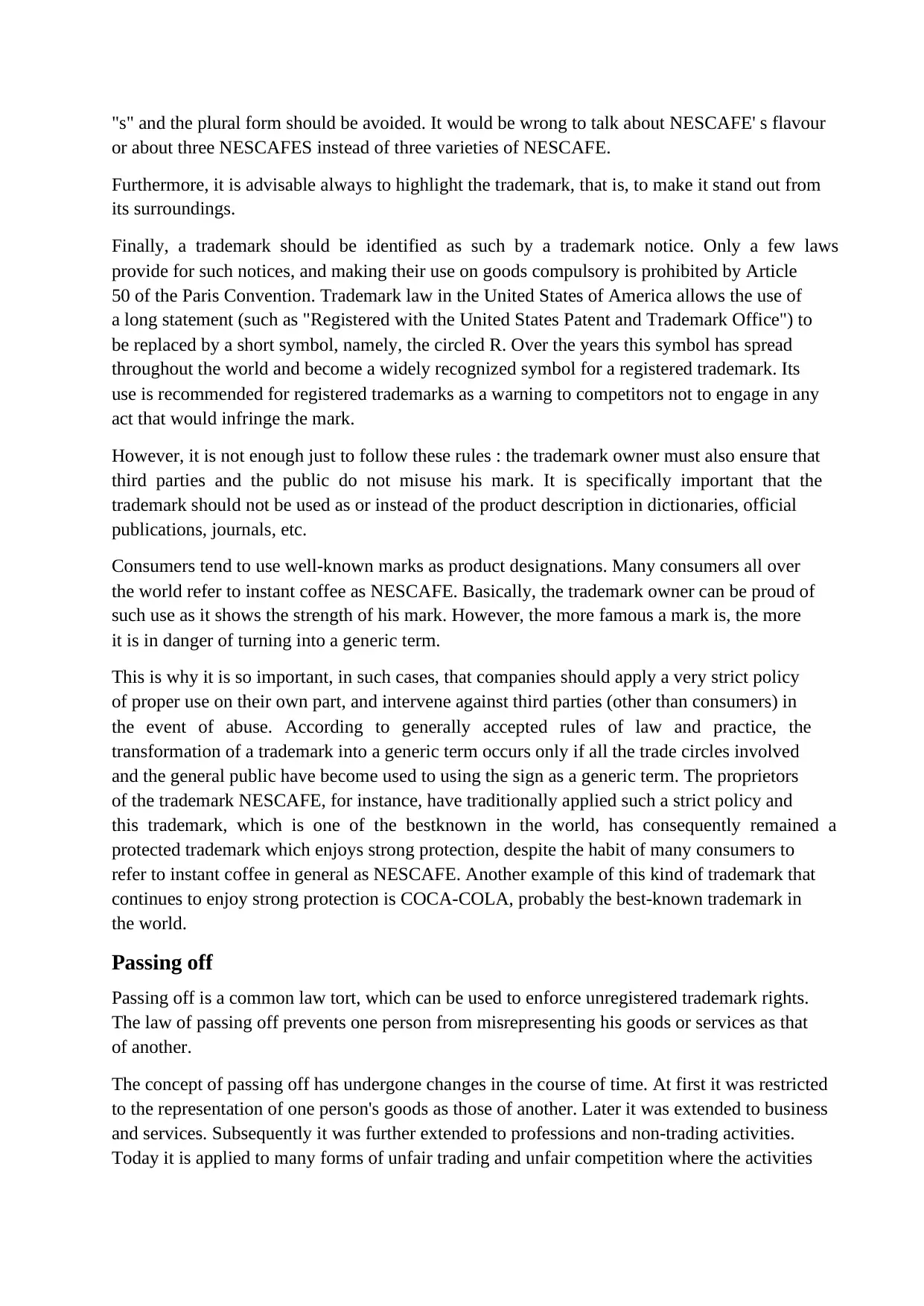
"s" and the plural form should be avoided. It would be wrong to talk about NESCAFE' s flavour
or about three NESCAFES instead of three varieties of NESCAFE.
Furthermore, it is advisable always to highlight the trademark, that is, to make it stand out from
its surroundings.
Finally, a trademark should be identified as such by a trademark notice. Only a few laws
provide for such notices, and making their use on goods compulsory is prohibited by Article
50 of the Paris Convention. Trademark law in the United States of America allows the use of
a long statement (such as "Registered with the United States Patent and Trademark Office") to
be replaced by a short symbol, namely, the circled R. Over the years this symbol has spread
throughout the world and become a widely recognized symbol for a registered trademark. Its
use is recommended for registered trademarks as a warning to competitors not to engage in any
act that would infringe the mark.
However, it is not enough just to follow these rules : the trademark owner must also ensure that
third parties and the public do not misuse his mark. It is specifically important that the
trademark should not be used as or instead of the product description in dictionaries, official
publications, journals, etc.
Consumers tend to use well-known marks as product designations. Many consumers all over
the world refer to instant coffee as NESCAFE. Basically, the trademark owner can be proud of
such use as it shows the strength of his mark. However, the more famous a mark is, the more
it is in danger of turning into a generic term.
This is why it is so important, in such cases, that companies should apply a very strict policy
of proper use on their own part, and intervene against third parties (other than consumers) in
the event of abuse. According to generally accepted rules of law and practice, the
transformation of a trademark into a generic term occurs only if all the trade circles involved
and the general public have become used to using the sign as a generic term. The proprietors
of the trademark NESCAFE, for instance, have traditionally applied such a strict policy and
this trademark, which is one of the bestknown in the world, has consequently remained a
protected trademark which enjoys strong protection, despite the habit of many consumers to
refer to instant coffee in general as NESCAFE. Another example of this kind of trademark that
continues to enjoy strong protection is COCA-COLA, probably the best-known trademark in
the world.
Passing off
Passing off is a common law tort, which can be used to enforce unregistered trademark rights.
The law of passing off prevents one person from misrepresenting his goods or services as that
of another.
The concept of passing off has undergone changes in the course of time. At first it was restricted
to the representation of one person's goods as those of another. Later it was extended to business
and services. Subsequently it was further extended to professions and non-trading activities.
Today it is applied to many forms of unfair trading and unfair competition where the activities
or about three NESCAFES instead of three varieties of NESCAFE.
Furthermore, it is advisable always to highlight the trademark, that is, to make it stand out from
its surroundings.
Finally, a trademark should be identified as such by a trademark notice. Only a few laws
provide for such notices, and making their use on goods compulsory is prohibited by Article
50 of the Paris Convention. Trademark law in the United States of America allows the use of
a long statement (such as "Registered with the United States Patent and Trademark Office") to
be replaced by a short symbol, namely, the circled R. Over the years this symbol has spread
throughout the world and become a widely recognized symbol for a registered trademark. Its
use is recommended for registered trademarks as a warning to competitors not to engage in any
act that would infringe the mark.
However, it is not enough just to follow these rules : the trademark owner must also ensure that
third parties and the public do not misuse his mark. It is specifically important that the
trademark should not be used as or instead of the product description in dictionaries, official
publications, journals, etc.
Consumers tend to use well-known marks as product designations. Many consumers all over
the world refer to instant coffee as NESCAFE. Basically, the trademark owner can be proud of
such use as it shows the strength of his mark. However, the more famous a mark is, the more
it is in danger of turning into a generic term.
This is why it is so important, in such cases, that companies should apply a very strict policy
of proper use on their own part, and intervene against third parties (other than consumers) in
the event of abuse. According to generally accepted rules of law and practice, the
transformation of a trademark into a generic term occurs only if all the trade circles involved
and the general public have become used to using the sign as a generic term. The proprietors
of the trademark NESCAFE, for instance, have traditionally applied such a strict policy and
this trademark, which is one of the bestknown in the world, has consequently remained a
protected trademark which enjoys strong protection, despite the habit of many consumers to
refer to instant coffee in general as NESCAFE. Another example of this kind of trademark that
continues to enjoy strong protection is COCA-COLA, probably the best-known trademark in
the world.
Passing off
Passing off is a common law tort, which can be used to enforce unregistered trademark rights.
The law of passing off prevents one person from misrepresenting his goods or services as that
of another.
The concept of passing off has undergone changes in the course of time. At first it was restricted
to the representation of one person's goods as those of another. Later it was extended to business
and services. Subsequently it was further extended to professions and non-trading activities.
Today it is applied to many forms of unfair trading and unfair competition where the activities
Secure Best Marks with AI Grader
Need help grading? Try our AI Grader for instant feedback on your assignments.
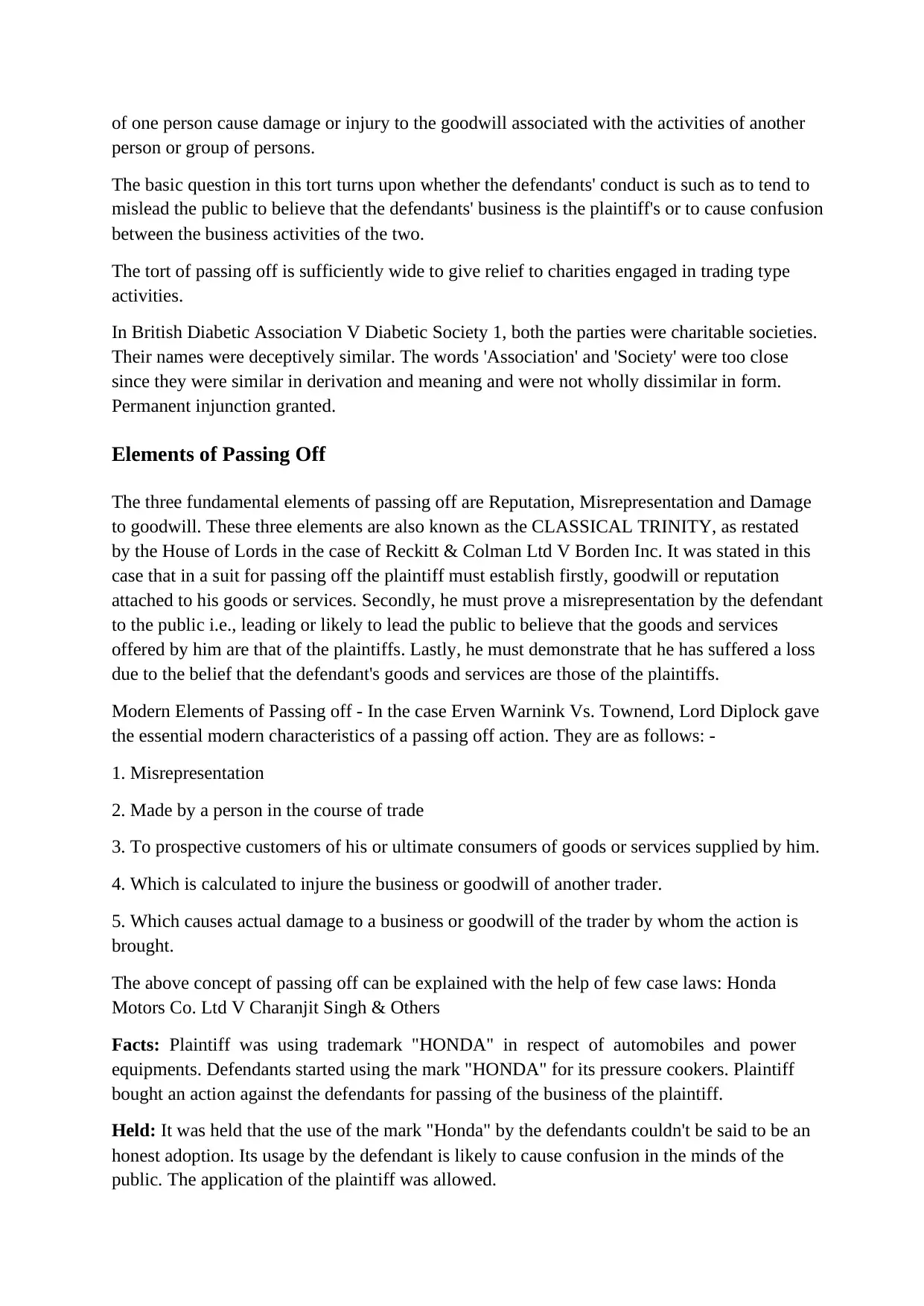
of one person cause damage or injury to the goodwill associated with the activities of another
person or group of persons.
The basic question in this tort turns upon whether the defendants' conduct is such as to tend to
mislead the public to believe that the defendants' business is the plaintiff's or to cause confusion
between the business activities of the two.
The tort of passing off is sufficiently wide to give relief to charities engaged in trading type
activities.
In British Diabetic Association V Diabetic Society 1, both the parties were charitable societies.
Their names were deceptively similar. The words 'Association' and 'Society' were too close
since they were similar in derivation and meaning and were not wholly dissimilar in form.
Permanent injunction granted.
Elements of Passing Off
The three fundamental elements of passing off are Reputation, Misrepresentation and Damage
to goodwill. These three elements are also known as the CLASSICAL TRINITY, as restated
by the House of Lords in the case of Reckitt & Colman Ltd V Borden Inc. It was stated in this
case that in a suit for passing off the plaintiff must establish firstly, goodwill or reputation
attached to his goods or services. Secondly, he must prove a misrepresentation by the defendant
to the public i.e., leading or likely to lead the public to believe that the goods and services
offered by him are that of the plaintiffs. Lastly, he must demonstrate that he has suffered a loss
due to the belief that the defendant's goods and services are those of the plaintiffs.
Modern Elements of Passing off - In the case Erven Warnink Vs. Townend, Lord Diplock gave
the essential modern characteristics of a passing off action. They are as follows: -
1. Misrepresentation
2. Made by a person in the course of trade
3. To prospective customers of his or ultimate consumers of goods or services supplied by him.
4. Which is calculated to injure the business or goodwill of another trader.
5. Which causes actual damage to a business or goodwill of the trader by whom the action is
brought.
The above concept of passing off can be explained with the help of few case laws: Honda
Motors Co. Ltd V Charanjit Singh & Others
Facts: Plaintiff was using trademark "HONDA" in respect of automobiles and power
equipments. Defendants started using the mark "HONDA" for its pressure cookers. Plaintiff
bought an action against the defendants for passing of the business of the plaintiff.
Held: It was held that the use of the mark "Honda" by the defendants couldn't be said to be an
honest adoption. Its usage by the defendant is likely to cause confusion in the minds of the
public. The application of the plaintiff was allowed.
person or group of persons.
The basic question in this tort turns upon whether the defendants' conduct is such as to tend to
mislead the public to believe that the defendants' business is the plaintiff's or to cause confusion
between the business activities of the two.
The tort of passing off is sufficiently wide to give relief to charities engaged in trading type
activities.
In British Diabetic Association V Diabetic Society 1, both the parties were charitable societies.
Their names were deceptively similar. The words 'Association' and 'Society' were too close
since they were similar in derivation and meaning and were not wholly dissimilar in form.
Permanent injunction granted.
Elements of Passing Off
The three fundamental elements of passing off are Reputation, Misrepresentation and Damage
to goodwill. These three elements are also known as the CLASSICAL TRINITY, as restated
by the House of Lords in the case of Reckitt & Colman Ltd V Borden Inc. It was stated in this
case that in a suit for passing off the plaintiff must establish firstly, goodwill or reputation
attached to his goods or services. Secondly, he must prove a misrepresentation by the defendant
to the public i.e., leading or likely to lead the public to believe that the goods and services
offered by him are that of the plaintiffs. Lastly, he must demonstrate that he has suffered a loss
due to the belief that the defendant's goods and services are those of the plaintiffs.
Modern Elements of Passing off - In the case Erven Warnink Vs. Townend, Lord Diplock gave
the essential modern characteristics of a passing off action. They are as follows: -
1. Misrepresentation
2. Made by a person in the course of trade
3. To prospective customers of his or ultimate consumers of goods or services supplied by him.
4. Which is calculated to injure the business or goodwill of another trader.
5. Which causes actual damage to a business or goodwill of the trader by whom the action is
brought.
The above concept of passing off can be explained with the help of few case laws: Honda
Motors Co. Ltd V Charanjit Singh & Others
Facts: Plaintiff was using trademark "HONDA" in respect of automobiles and power
equipments. Defendants started using the mark "HONDA" for its pressure cookers. Plaintiff
bought an action against the defendants for passing of the business of the plaintiff.
Held: It was held that the use of the mark "Honda" by the defendants couldn't be said to be an
honest adoption. Its usage by the defendant is likely to cause confusion in the minds of the
public. The application of the plaintiff was allowed.
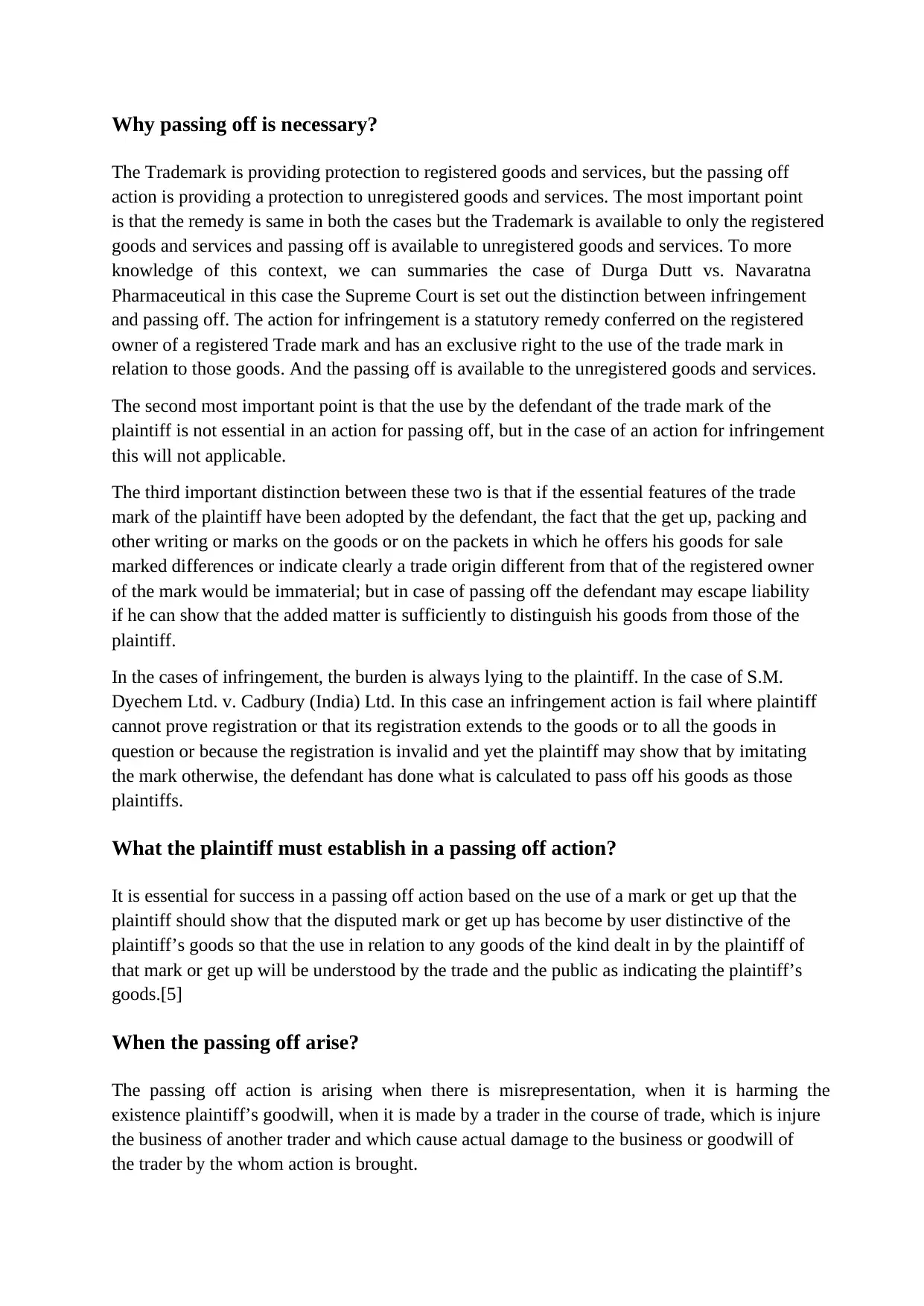
Why passing off is necessary?
The Trademark is providing protection to registered goods and services, but the passing off
action is providing a protection to unregistered goods and services. The most important point
is that the remedy is same in both the cases but the Trademark is available to only the registered
goods and services and passing off is available to unregistered goods and services. To more
knowledge of this context, we can summaries the case of Durga Dutt vs. Navaratna
Pharmaceutical in this case the Supreme Court is set out the distinction between infringement
and passing off. The action for infringement is a statutory remedy conferred on the registered
owner of a registered Trade mark and has an exclusive right to the use of the trade mark in
relation to those goods. And the passing off is available to the unregistered goods and services.
The second most important point is that the use by the defendant of the trade mark of the
plaintiff is not essential in an action for passing off, but in the case of an action for infringement
this will not applicable.
The third important distinction between these two is that if the essential features of the trade
mark of the plaintiff have been adopted by the defendant, the fact that the get up, packing and
other writing or marks on the goods or on the packets in which he offers his goods for sale
marked differences or indicate clearly a trade origin different from that of the registered owner
of the mark would be immaterial; but in case of passing off the defendant may escape liability
if he can show that the added matter is sufficiently to distinguish his goods from those of the
plaintiff.
In the cases of infringement, the burden is always lying to the plaintiff. In the case of S.M.
Dyechem Ltd. v. Cadbury (India) Ltd. In this case an infringement action is fail where plaintiff
cannot prove registration or that its registration extends to the goods or to all the goods in
question or because the registration is invalid and yet the plaintiff may show that by imitating
the mark otherwise, the defendant has done what is calculated to pass off his goods as those
plaintiffs.
What the plaintiff must establish in a passing off action?
It is essential for success in a passing off action based on the use of a mark or get up that the
plaintiff should show that the disputed mark or get up has become by user distinctive of the
plaintiff’s goods so that the use in relation to any goods of the kind dealt in by the plaintiff of
that mark or get up will be understood by the trade and the public as indicating the plaintiff’s
goods.[5]
When the passing off arise?
The passing off action is arising when there is misrepresentation, when it is harming the
existence plaintiff’s goodwill, when it is made by a trader in the course of trade, which is injure
the business of another trader and which cause actual damage to the business or goodwill of
the trader by the whom action is brought.
The Trademark is providing protection to registered goods and services, but the passing off
action is providing a protection to unregistered goods and services. The most important point
is that the remedy is same in both the cases but the Trademark is available to only the registered
goods and services and passing off is available to unregistered goods and services. To more
knowledge of this context, we can summaries the case of Durga Dutt vs. Navaratna
Pharmaceutical in this case the Supreme Court is set out the distinction between infringement
and passing off. The action for infringement is a statutory remedy conferred on the registered
owner of a registered Trade mark and has an exclusive right to the use of the trade mark in
relation to those goods. And the passing off is available to the unregistered goods and services.
The second most important point is that the use by the defendant of the trade mark of the
plaintiff is not essential in an action for passing off, but in the case of an action for infringement
this will not applicable.
The third important distinction between these two is that if the essential features of the trade
mark of the plaintiff have been adopted by the defendant, the fact that the get up, packing and
other writing or marks on the goods or on the packets in which he offers his goods for sale
marked differences or indicate clearly a trade origin different from that of the registered owner
of the mark would be immaterial; but in case of passing off the defendant may escape liability
if he can show that the added matter is sufficiently to distinguish his goods from those of the
plaintiff.
In the cases of infringement, the burden is always lying to the plaintiff. In the case of S.M.
Dyechem Ltd. v. Cadbury (India) Ltd. In this case an infringement action is fail where plaintiff
cannot prove registration or that its registration extends to the goods or to all the goods in
question or because the registration is invalid and yet the plaintiff may show that by imitating
the mark otherwise, the defendant has done what is calculated to pass off his goods as those
plaintiffs.
What the plaintiff must establish in a passing off action?
It is essential for success in a passing off action based on the use of a mark or get up that the
plaintiff should show that the disputed mark or get up has become by user distinctive of the
plaintiff’s goods so that the use in relation to any goods of the kind dealt in by the plaintiff of
that mark or get up will be understood by the trade and the public as indicating the plaintiff’s
goods.[5]
When the passing off arise?
The passing off action is arising when there is misrepresentation, when it is harming the
existence plaintiff’s goodwill, when it is made by a trader in the course of trade, which is injure
the business of another trader and which cause actual damage to the business or goodwill of
the trader by the whom action is brought.
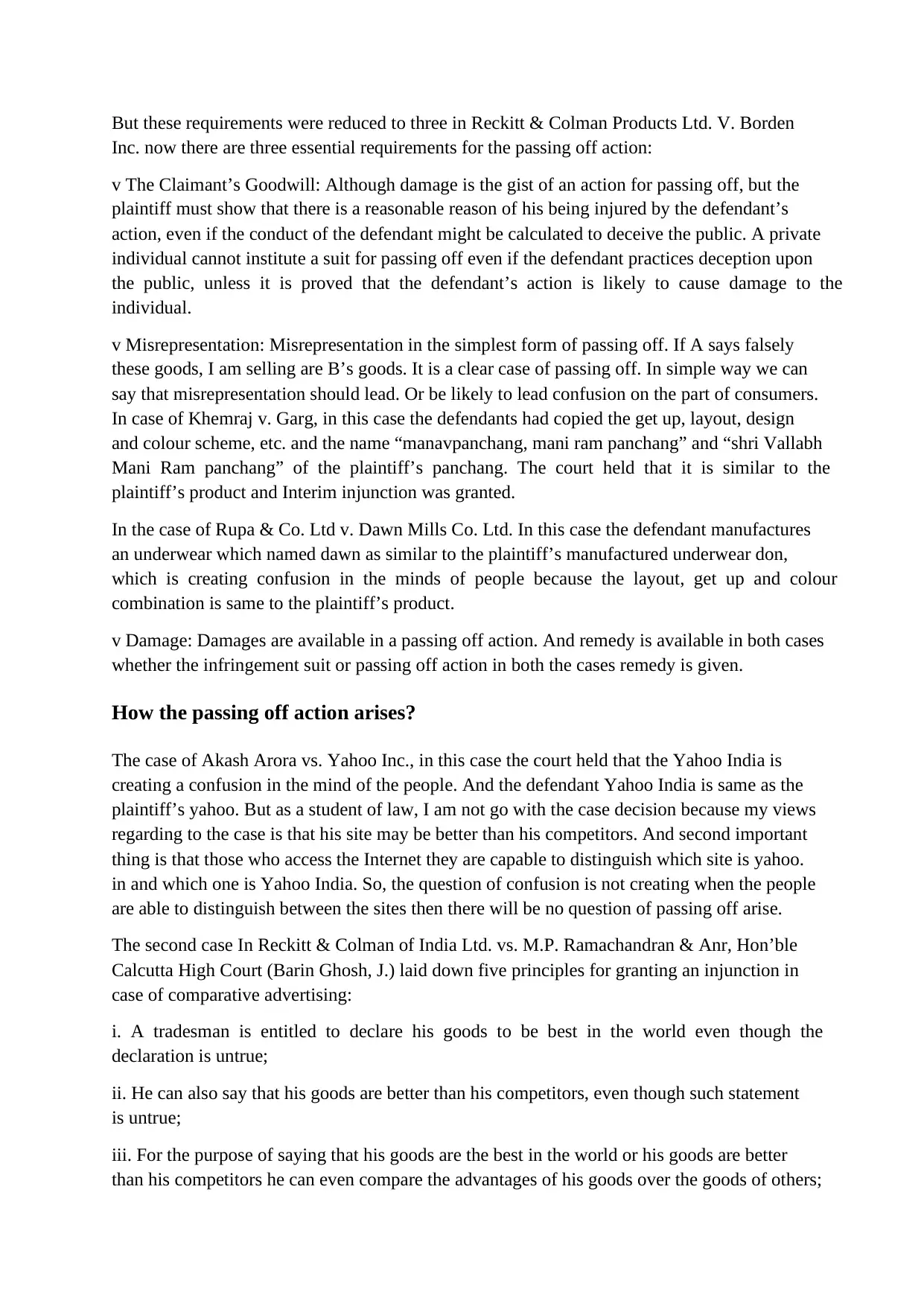
But these requirements were reduced to three in Reckitt & Colman Products Ltd. V. Borden
Inc. now there are three essential requirements for the passing off action:
v The Claimant’s Goodwill: Although damage is the gist of an action for passing off, but the
plaintiff must show that there is a reasonable reason of his being injured by the defendant’s
action, even if the conduct of the defendant might be calculated to deceive the public. A private
individual cannot institute a suit for passing off even if the defendant practices deception upon
the public, unless it is proved that the defendant’s action is likely to cause damage to the
individual.
v Misrepresentation: Misrepresentation in the simplest form of passing off. If A says falsely
these goods, I am selling are B’s goods. It is a clear case of passing off. In simple way we can
say that misrepresentation should lead. Or be likely to lead confusion on the part of consumers.
In case of Khemraj v. Garg, in this case the defendants had copied the get up, layout, design
and colour scheme, etc. and the name “manavpanchang, mani ram panchang” and “shri Vallabh
Mani Ram panchang” of the plaintiff’s panchang. The court held that it is similar to the
plaintiff’s product and Interim injunction was granted.
In the case of Rupa & Co. Ltd v. Dawn Mills Co. Ltd. In this case the defendant manufactures
an underwear which named dawn as similar to the plaintiff’s manufactured underwear don,
which is creating confusion in the minds of people because the layout, get up and colour
combination is same to the plaintiff’s product.
v Damage: Damages are available in a passing off action. And remedy is available in both cases
whether the infringement suit or passing off action in both the cases remedy is given.
How the passing off action arises?
The case of Akash Arora vs. Yahoo Inc., in this case the court held that the Yahoo India is
creating a confusion in the mind of the people. And the defendant Yahoo India is same as the
plaintiff’s yahoo. But as a student of law, I am not go with the case decision because my views
regarding to the case is that his site may be better than his competitors. And second important
thing is that those who access the Internet they are capable to distinguish which site is yahoo.
in and which one is Yahoo India. So, the question of confusion is not creating when the people
are able to distinguish between the sites then there will be no question of passing off arise.
The second case In Reckitt & Colman of India Ltd. vs. M.P. Ramachandran & Anr, Hon’ble
Calcutta High Court (Barin Ghosh, J.) laid down five principles for granting an injunction in
case of comparative advertising:
i. A tradesman is entitled to declare his goods to be best in the world even though the
declaration is untrue;
ii. He can also say that his goods are better than his competitors, even though such statement
is untrue;
iii. For the purpose of saying that his goods are the best in the world or his goods are better
than his competitors he can even compare the advantages of his goods over the goods of others;
Inc. now there are three essential requirements for the passing off action:
v The Claimant’s Goodwill: Although damage is the gist of an action for passing off, but the
plaintiff must show that there is a reasonable reason of his being injured by the defendant’s
action, even if the conduct of the defendant might be calculated to deceive the public. A private
individual cannot institute a suit for passing off even if the defendant practices deception upon
the public, unless it is proved that the defendant’s action is likely to cause damage to the
individual.
v Misrepresentation: Misrepresentation in the simplest form of passing off. If A says falsely
these goods, I am selling are B’s goods. It is a clear case of passing off. In simple way we can
say that misrepresentation should lead. Or be likely to lead confusion on the part of consumers.
In case of Khemraj v. Garg, in this case the defendants had copied the get up, layout, design
and colour scheme, etc. and the name “manavpanchang, mani ram panchang” and “shri Vallabh
Mani Ram panchang” of the plaintiff’s panchang. The court held that it is similar to the
plaintiff’s product and Interim injunction was granted.
In the case of Rupa & Co. Ltd v. Dawn Mills Co. Ltd. In this case the defendant manufactures
an underwear which named dawn as similar to the plaintiff’s manufactured underwear don,
which is creating confusion in the minds of people because the layout, get up and colour
combination is same to the plaintiff’s product.
v Damage: Damages are available in a passing off action. And remedy is available in both cases
whether the infringement suit or passing off action in both the cases remedy is given.
How the passing off action arises?
The case of Akash Arora vs. Yahoo Inc., in this case the court held that the Yahoo India is
creating a confusion in the mind of the people. And the defendant Yahoo India is same as the
plaintiff’s yahoo. But as a student of law, I am not go with the case decision because my views
regarding to the case is that his site may be better than his competitors. And second important
thing is that those who access the Internet they are capable to distinguish which site is yahoo.
in and which one is Yahoo India. So, the question of confusion is not creating when the people
are able to distinguish between the sites then there will be no question of passing off arise.
The second case In Reckitt & Colman of India Ltd. vs. M.P. Ramachandran & Anr, Hon’ble
Calcutta High Court (Barin Ghosh, J.) laid down five principles for granting an injunction in
case of comparative advertising:
i. A tradesman is entitled to declare his goods to be best in the world even though the
declaration is untrue;
ii. He can also say that his goods are better than his competitors, even though such statement
is untrue;
iii. For the purpose of saying that his goods are the best in the world or his goods are better
than his competitors he can even compare the advantages of his goods over the goods of others;
Paraphrase This Document
Need a fresh take? Get an instant paraphrase of this document with our AI Paraphraser
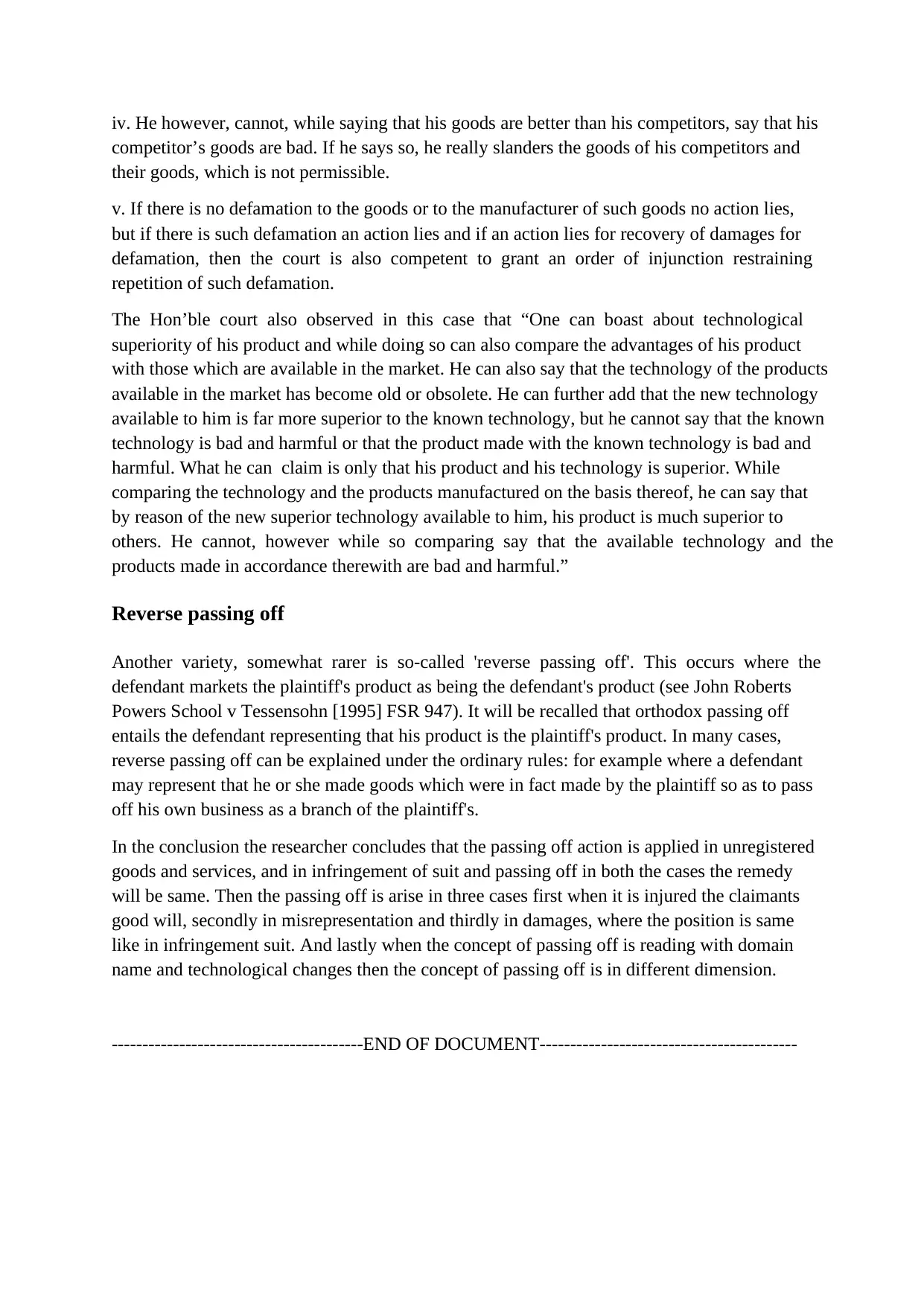
iv. He however, cannot, while saying that his goods are better than his competitors, say that his
competitor’s goods are bad. If he says so, he really slanders the goods of his competitors and
their goods, which is not permissible.
v. If there is no defamation to the goods or to the manufacturer of such goods no action lies,
but if there is such defamation an action lies and if an action lies for recovery of damages for
defamation, then the court is also competent to grant an order of injunction restraining
repetition of such defamation.
The Hon’ble court also observed in this case that “One can boast about technological
superiority of his product and while doing so can also compare the advantages of his product
with those which are available in the market. He can also say that the technology of the products
available in the market has become old or obsolete. He can further add that the new technology
available to him is far more superior to the known technology, but he cannot say that the known
technology is bad and harmful or that the product made with the known technology is bad and
harmful. What he can claim is only that his product and his technology is superior. While
comparing the technology and the products manufactured on the basis thereof, he can say that
by reason of the new superior technology available to him, his product is much superior to
others. He cannot, however while so comparing say that the available technology and the
products made in accordance therewith are bad and harmful.”
Reverse passing off
Another variety, somewhat rarer is so-called 'reverse passing off'. This occurs where the
defendant markets the plaintiff's product as being the defendant's product (see John Roberts
Powers School v Tessensohn [1995] FSR 947). It will be recalled that orthodox passing off
entails the defendant representing that his product is the plaintiff's product. In many cases,
reverse passing off can be explained under the ordinary rules: for example where a defendant
may represent that he or she made goods which were in fact made by the plaintiff so as to pass
off his own business as a branch of the plaintiff's.
In the conclusion the researcher concludes that the passing off action is applied in unregistered
goods and services, and in infringement of suit and passing off in both the cases the remedy
will be same. Then the passing off is arise in three cases first when it is injured the claimants
good will, secondly in misrepresentation and thirdly in damages, where the position is same
like in infringement suit. And lastly when the concept of passing off is reading with domain
name and technological changes then the concept of passing off is in different dimension.
-----------------------------------------END OF DOCUMENT------------------------------------------
competitor’s goods are bad. If he says so, he really slanders the goods of his competitors and
their goods, which is not permissible.
v. If there is no defamation to the goods or to the manufacturer of such goods no action lies,
but if there is such defamation an action lies and if an action lies for recovery of damages for
defamation, then the court is also competent to grant an order of injunction restraining
repetition of such defamation.
The Hon’ble court also observed in this case that “One can boast about technological
superiority of his product and while doing so can also compare the advantages of his product
with those which are available in the market. He can also say that the technology of the products
available in the market has become old or obsolete. He can further add that the new technology
available to him is far more superior to the known technology, but he cannot say that the known
technology is bad and harmful or that the product made with the known technology is bad and
harmful. What he can claim is only that his product and his technology is superior. While
comparing the technology and the products manufactured on the basis thereof, he can say that
by reason of the new superior technology available to him, his product is much superior to
others. He cannot, however while so comparing say that the available technology and the
products made in accordance therewith are bad and harmful.”
Reverse passing off
Another variety, somewhat rarer is so-called 'reverse passing off'. This occurs where the
defendant markets the plaintiff's product as being the defendant's product (see John Roberts
Powers School v Tessensohn [1995] FSR 947). It will be recalled that orthodox passing off
entails the defendant representing that his product is the plaintiff's product. In many cases,
reverse passing off can be explained under the ordinary rules: for example where a defendant
may represent that he or she made goods which were in fact made by the plaintiff so as to pass
off his own business as a branch of the plaintiff's.
In the conclusion the researcher concludes that the passing off action is applied in unregistered
goods and services, and in infringement of suit and passing off in both the cases the remedy
will be same. Then the passing off is arise in three cases first when it is injured the claimants
good will, secondly in misrepresentation and thirdly in damages, where the position is same
like in infringement suit. And lastly when the concept of passing off is reading with domain
name and technological changes then the concept of passing off is in different dimension.
-----------------------------------------END OF DOCUMENT------------------------------------------
1 out of 14
Related Documents
Your All-in-One AI-Powered Toolkit for Academic Success.
+13062052269
info@desklib.com
Available 24*7 on WhatsApp / Email
![[object Object]](/_next/static/media/star-bottom.7253800d.svg)
Unlock your academic potential
© 2024 | Zucol Services PVT LTD | All rights reserved.




